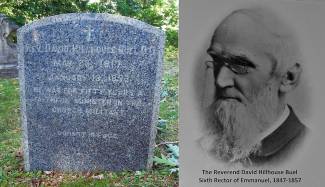Collection Name
About
Reverend David Hillhouse Buel, 1817-1893
The biography below is taken directly from the Maryland State Archives. The Reverend Buel is referenced in several narratives appearing on this site pertaining to the Emmanuel Episcopal Church and the Underground Railroad. It should be noted that the spelling Samuel "Demson" below should be Denson. We also use the spelling "Buel", rather than "Buell" as that is the spelling appearing on the Reverend's tombstone. A biography of Samuel Middleton Semmes, who is also referenced below, appears elsewhere on this website as well. The birth and death date for Reverend Buel were obtained from his tombstone, which notes that "He was for fifty years a faithful minister in the church militant - Dormit in Pace." He is buried in Troy, New York.
Biography:
Local folklore of the Shantytown in Cumberland recorded during the construction of the Chesapeake and Ohio Canal said that many runaway slaves passed through Cumberland in the 1850s when the Reverend Hillhouse Buell was rector of the Emmanuel Episcopal Church. The Buells were from New York and were known to be Union sympathizers. During Buell’s tenure at Emmanuel, there was a noticeable increase in the number of African-American slaves as well as freemen listed in the parish records.
Another noteworthy episode occurred at the church under Buell's leadership: a local farmer, Samuel Middleton Semmes, was a Roman Catholic and he wanted his slaves to receive communion; however, the pastor of Saint Patrick’s Roman Catholic Church, which was less than a mile from Emmanuel, did not believe that Blacks should receive communion. Semmes approached Hillhouse Buell with a pledge of five thousand dollars to the church construction fund, on condition that a balcony be built for the slaves. Buell agreed to add the balcony and to offer the slaves communion. However, the slaves still did not receive communion because they had been baptized Roman Catholic and did not wish to receive communion in an Episcopal Church. Semmes became a member of Emmanuel on March 3, 1849.
Hillhouse Buell's outreach to African-Americans extended beyond the church walls, for his church was a "stop" on the Underground Railroad. The many runaway ads which mentioned the Canal as a possible route or destination are evidence that the construction of the Chesapeake and Ohio Canal offered some slaves an opportunity to run away. The runaways would follow the canal to Cumberland and while under the cover of the high brush, they would wait for a signal from the church. Samuel Demson, a free black who had escaped to Maryland from Mississippi, rang the church bell twice when the coast was clear. The runaways would come up the hill to a gate, which led to a maze of tunnels under the church. After resting, receiving food and instructions, the runaways were taken through the tunnels that exited to the other side of the rectory which was across the road, from which point it was only a five mile walk to the Mason-Dixon Line and freedom.
It should be noted that research undertaken in recent years by Dan Whetzel and other historians call into question the accuracy of the historical accounts, timing and relationship among Samuel Denson, the Underground Railroad and Emmanuel Episcopal Church. As always, and without real documentation, this should be considered within the context of the oral history and folklore as it has been passed down to this time. We have posted some of this recent research elsewhere on this website.
The biography is from the Archives of Maryland (Biographical Series) Reverend Hillhouse Buell (b. ? - d. ?)MSA SC 5496-10599 Accomplice to slave flight, Alleghany County, Maryland, 1850s
The photo of Rev. Buel's grave came from Find a Grave: Rev David Hillhouse Buel
Photo of Reverend D.H. Buel provided courtesy of Emmanuel Episcopal Church.
